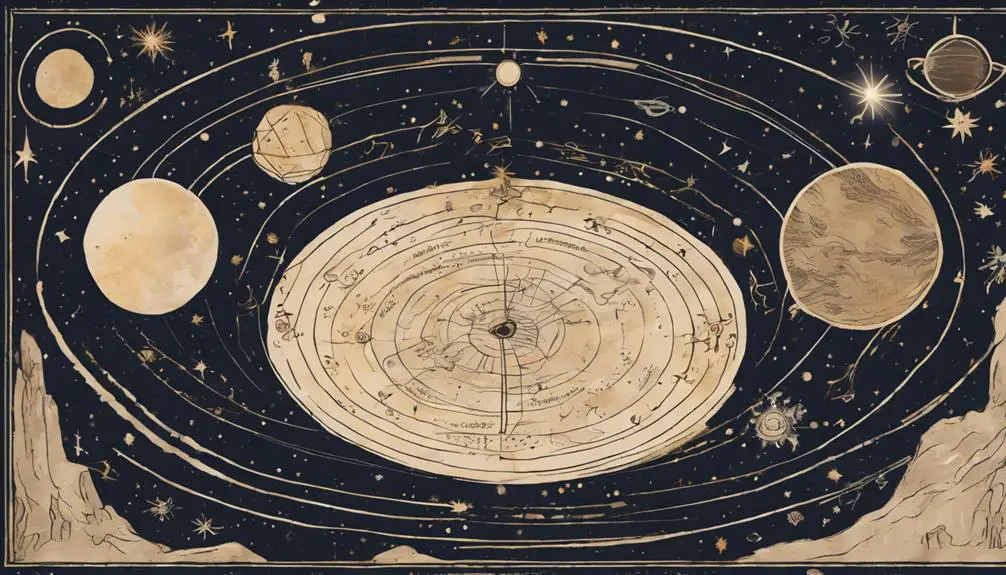Learn how the ancient cosmos is depicted in the Bible KJV, revealing mysteries beyond our Earth that captivate the imagination.

Planets in the Bible Kjv
Have you ever gazed up at the night sky, marveling at its mysteries, and wondered how the ancient texts of the Bible address the vast cosmos? You're not alone in your curiosity.
The King James Version of the Bible, while not a scientific document, contains intriguing references to celestial bodies that have sparked debates among scholars and theologians alike. As we embark on this exploration, you'll discover the nuanced ways in which planets and stars are woven into the biblical narrative.
What might these references tell us about the worldview of ancient writers? The answers may surprise you, inviting you to look at familiar passages in a new light.
Key Takeaways
- The Bible uses celestial bodies, including planets, as metaphors for divine guidance and oversight.
- Venus, as the Morning Star, symbolizes hope and divine promise in biblical texts.
- Cultural and historical contexts of ancient astronomy enrich the understanding of planetary references in the Bible.
- Stars and planets in the Bible reflect the integration of cosmic observations with theological concepts.
Biblical References to Celestial Bodies

The Bible frequently touches upon celestial bodies, offering insights that blend theological significance with the natural world. You'll find that cosmic metaphors are a pivotal aspect of biblical language, illuminating themes of guidance, divine oversight, and the passage of time. Consider how lunar cycles are referenced to mark periods and festivals, embodying a deep connection between the heavens and the earthly realm. This usage not only reflects an appreciation for the natural order but also embeds celestial phenomena within the fabric of spiritual life.
In analyzing these references, it's clear that the biblical authors utilized observations of the night sky to articulate complex theological ideas. The moon's phases, for instance, serve as a powerful symbol of renewal and redemption, resonating with the cyclic nature of human experience. Such cosmic metaphors extend beyond mere analogy, suggesting a worldview in which the heavens are a canvas for divine action and instruction. Through this lens, the biblical narrative encourages you to perceive celestial bodies not as distant, inert objects but as vibrant elements of a creation imbued with purpose and meaning.
Interpreting Ancient Astronomy

Delving into ancient astronomy, you'll uncover how early civilizations meticulously observed the heavens, integrating their findings into both daily life and broader cosmological understandings. These societies didn't just see patterns in the stars; they read them as cosmic narratives, encoding their myths, gods, and the very essence of their cultures into celestial arrangements. This deep connection gave rise to cosmic myths, stories that explained the universe's origin, its mechanics, and its purpose through the positions and movements of celestial bodies.
Star worship was an extension of this cosmic curiosity, with many cultures venerating celestial objects as deities or divine messengers. This wasn't mere superstition; it was a complex synthesis of religion, science, and philosophy, where the heavens served as both a clock and a canvas. By studying the stars, ancient astronomers could predict seasons, navigate vast distances, and even divine the future, embedding these practices into the fabric of their societies.
Your journey into interpreting ancient astronomy reveals a world where the sky was a source of wonder, guidance, and spiritual reflection. These early astronomers laid the groundwork for our modern understanding of the universe, proving that humanity's fascination with the cosmos is as old as civilization itself.
The Planet Venus in Scripture

Building on our understanding of ancient astronomy's impact on culture and religion, we'll now examine how scripture references the planet Venus, highlighting its symbolic significance in biblical texts. The appearance of Venus in the sky hasn't gone unnoticed; its presence has woven itself into the fabric of biblical narrative, often shrouded in the mystique of Venus myths. This celestial body, especially as the Morning Star, serves as a powerful metaphor in scripture, embodying themes of hope, renewal, and divine guidance.
You'll find that Venus's dual aspect as both the Morning and Evening Star has lent itself to rich interpretive layers within biblical texts. This duality mirrors the complexities of human nature and divine intervention, offering a multifaceted symbol that theologians and scholars have pondered over for centuries. Despite the scarcity of direct mentions, the indirect references to Venus as the Morning Star in particular carry significant weight. They evoke a sense of anticipation and the promise of a new dawn, encapsulating the essence of salvation and redemption themes prevalent in scripture.
These references to Venus, though not always explicit, enrich our understanding of how celestial phenomena were integrated into the spiritual and existential questions that biblical texts seek to address.
Symbolism of the Stars

Throughout history, stars haven't only illuminated the night sky but also served as profound symbols in biblical texts, reflecting themes of guidance, destiny, and divine oversight. This symbolism isn't merely incidental; it's woven into the fabric of the narratives, acting as cosmic metaphors for the divine will and human condition.
In the biblical context, stars often transcend their literal role as celestial bodies. They're employed as stellar parables, illustrating moral, spiritual, and eschatological truths. For instance, the multiplicity of stars symbolizes the innumerable descendants promised to Abraham, encapsulating a covenant that stretches as wide as the night sky. This isn't just a promise of progeny; it's a testament to faith's boundlessness and the expansive nature of divine commitment.
Moreover, stars function as markers of divine faithfulness and presence. Their steadfastness and predictability echo the unchanging nature of God's promises. In a world where life was precarious and futures uncertain, the stars offered a visible, tangible sign of a cosmic order under divine supervision. This symbolism underscores a worldview where humanity isn't adrift in chaos but is part of a larger, divinely guided cosmos.
Navigating Historical Contexts

To fully appreciate the biblical references to stars and planets, it's essential to explore the historical contexts in which these texts were written. The cultural interpretations of these celestial bodies during ancient times played a significant role in shaping their mention within the Bible. You'll find that the understanding and significance of planets vastly differed across cultures, influencing how they were represented in biblical passages.
Archaeological evidence has provided us with insights into how ancient civilizations viewed the cosmos. This evidence often reveals a deeply spiritual or mystical significance attributed to celestial bodies, including stars and planets. Such findings are crucial for interpreting biblical references to these entities in their proper context. For instance, the way ancient Hebrews perceived the stars could have influenced their inclusion in biblical texts, serving not just as physical objects but as symbols carrying deeper theological or cosmological meanings.
Navigating through these historical contexts requires a careful analysis of both the biblical text and the archaeological discoveries related to ancient cosmology. By understanding the cultural and historical backgrounds, you're better positioned to grasp the nuanced meanings behind the biblical mentions of stars and planets. This approach offers a more comprehensive understanding of these references, enriching your interpretation of the biblical narrative.
Frequently Asked Questions
How Does the Concept of Planets in the Bible KJV Compare to Modern Astronomical Definitions and Classifications?
When comparing historical cosmology to modern astronomy, you'll find significant discrepancies. The Bible's depiction of celestial bodies doesn't align with current scientific classifications and understandings. This gap highlights scientific inaccuracies inherent in ancient texts, viewed through the lens of their time.
Essentially, the Bible's references to the heavens don't match up with what we know today about planets, stars, and galaxies, showcasing a fascinating evolution in human comprehension of the cosmos.
Are There Any Lost or Apocryphal Texts That Mention Planets or Celestial Bodies Not Covered in the Canonical Bible Kjv?
You're exploring a realm where 'the stars tell stories,' delving into ancient cosmology and apocryphal astrology.
It's fascinating to uncover texts outside the canonical Bible that mention celestial bodies. These writings offer a glimpse into how ancient cultures perceived the cosmos.
They don't align perfectly with modern astronomical definitions, yet their insights into celestial phenomena broaden our understanding of human belief systems and their connection to the stars above.
How Have Different Christian Denominations Interpreted the Biblical References to Planets and Celestial Bodies Over the Centuries?
You'll find that Christian denominations have varied in interpreting biblical references to planets and celestial bodies, reflecting diverse views on cosmic theology and astral symbolism.
This diversity stems from differing theological frameworks and historical contexts. Some view these references as metaphorical, rich in symbolic meaning, while others see them as literal celestial entities.
Over centuries, this has led to a broad spectrum of beliefs and teachings within the Christian community.
What Role Do Planets and Celestial Bodies Play in Biblical Prophecies and Eschatology According to the Kjv?
As they say, 'The stars align' for a reason, especially in biblical prophecies and eschatology. Celestial metaphors and star symbolism play a pivotal role, serving as signs for the end times and divine interventions.
These elements aren't just ornamental; they're deeply embedded in the narrative to signal major events or shifts. Analyzing these symbols offers you a richer understanding of biblical messages, revealing how celestial bodies are intertwined with divine plans.
Can the Mention of Celestial Bodies in the Bible KJV Be Correlated With Specific Astronomical Events Known Today, Such as Comets, Supernovas, or Planetary Alignments?
You're diving into how celestial bodies mentioned in historical texts might align with known astronomical events. This requires analyzing historical context and cultural interpretations to draw connections.
By scrutinizing passages, you can investigate if references to stars or unusual lights might correspond to comets, supernovas, or planetary alignments documented by astronomers.
Your inquiry blends scholarly analysis with objective evaluation, aiming to bridge ancient descriptions with modern astronomical understanding.
Conclusion
In your exploration of celestial bodies within the biblical context, you've uncovered how ancient texts reflect humanity's early astronomical observations. Particularly, the mention of Venus stands out, not just as a celestial marker but as a symbol woven into the fabric of biblical narratives.
It's fascinating to note that despite the limited astronomical knowledge, the Bible references at least seven times the morning star, often associated with Venus. This intersection of faith and science highlights the enduring human quest to understand the cosmos, underscoring our intrinsic curiosity and desire for connection with the universe.



Sign up